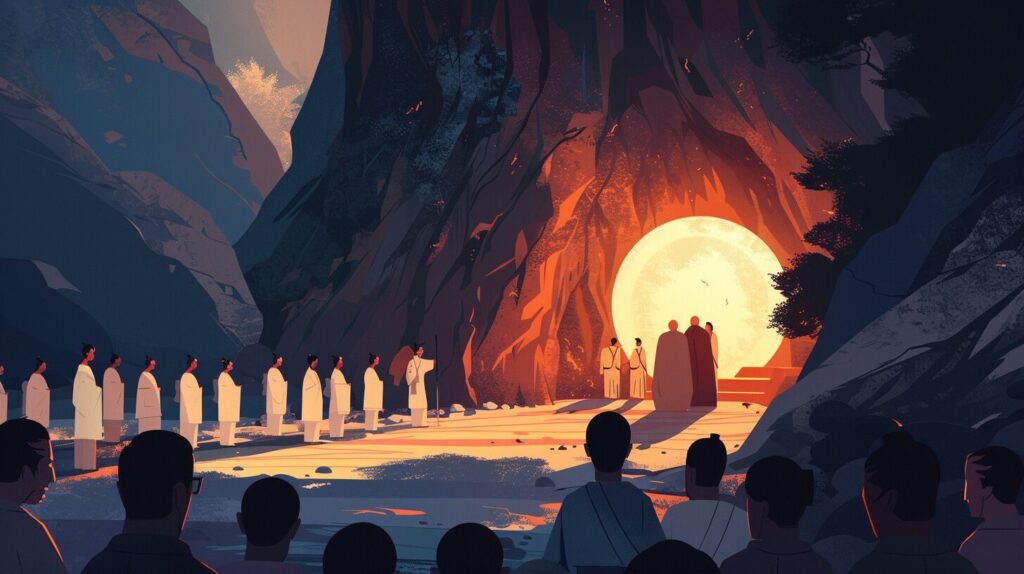日本最古の正史 日本書紀を英語で説明・紹介するための基本情報と、英会話に役立つ表現をシンプルでわかりやすい英語で紹介します。
英会話ダイアローグ・関連情報・10の質問を通して、日本書紀に関する英語表現を学びます。
英語
英会話ダイアローグを読む前に知っておくと良い前提知識と情報です。
- 日本書紀とは
- 720年に完成した日本最古の正式な歴史書の一つ
- 全30巻で構成され、漢文で書かれている
- 目的と特徴
- 皇室の正統性を示すために作られた
- 神話と歴史を組み合わせ天皇の系譜を強調
- 古事記との違い
- 古事記は日本書紀よりも物語的で、神話や伝説に重点を置いている
- 日本書紀はもっと正式で、歴史的な事実や国際関係に関する記録も含んでいる
- 有名な物語
- イザナギとイザナミによる日本創世神話や、アマテラスが岩戸に隠れる話、英雄ヤマトタケルの冒険などの神話や伝説が含まれている
2人が日本書紀について話しています。
日本書紀の成立年、構成や特徴、魅力、神話と歴史の融合、古事記との違いなどを話題にしています。
会話 / dialogue

Hey Key, I’ve been reading about Nihon Shoki recently. Do you know much about it?

Yeah, I’ve heard of it! It’s one of Japan’s oldest historical texts, right? What got you interested in Nihon Shoki?

I’ve always liked history, and Nihon Shoki is fascinating because it combines mythology and real historical events. I didn’t realize it was written on the orders of the emperor to show the legitimacy of the imperial family.

That’s right. It was completed in 720 and is written in classical Chinese. The book has 30 volumes, which is quite impressive for the time. What part of Nihon Shoki are you most interested in?

I think the mix of myth and history is really interesting. For example, the story of how the gods Izanagi and Izanami created Japan. It’s amazing how Nihon Shoki starts with these myths and then moves into real historical records.

Yeah, that’s one of its unique features. It blends the sacred myths with historical facts to emphasize the divine origin of the imperial family. And some of those myths, like the story of Amaterasu hiding in the cave, are still really important in Japanese culture today.

Exactly! And I also learned that Nihon Shoki was written to strengthen Japan’s position internationally, especially with China. It wasn’t just for Japanese readers.

True. The text was partly written to show other countries that Japan had a long and legitimate history, similar to China’s records. It wasn’t just about myths, but also about diplomacy and showing the emperor’s authority.

Speaking of authority, I read that Nihon Shoki focuses a lot on the imperial family’s genealogy. That’s different from Kojiki, right? Kojiki is more focused on the storytelling aspect?

Yes, exactly. Kojiki is more informal and poetic. It’s only three volumes and focuses more on myths and legends. Nihon Shoki, on the other hand, is much more structured and was meant to be an official record.

That’s really interesting. I didn’t realize Nihon Shoki had such a broad purpose—combining history, mythology, and even foreign relations.

And another great thing is the variety of stories in it. You’ve already mentioned the creation myth, but there’s also the story of Yamato Takeru, who was like a heroic warrior. He’s one of the most famous figures from ancient Japan.

Yeah, I’ve been meaning to read more about him. His adventures sound incredible, and I heard his tragic death is quite moving. It’s surprising how much emotional depth these stories have, even though they’re from so long ago.

Definitely. Nihon Shoki isn’t just dry history—it’s filled with adventure, mythology, and deep cultural meaning. That’s part of its charm.

Speaking of charm, the more I read, the more I appreciate how Nihon Shoki shaped Japan’s culture. I heard it even influenced later literature and art.

Absolutely. It had a huge impact on Japanese culture and still does today. You can see its influence in festivals, rituals, and even modern media. It really laid the foundation for how Japan views its own history.

I’m really glad I started reading it. There’s so much more to it than I expected. I’d love to dive deeper into the differences between Nihon Shoki and Kojiki too.

That would be a great next step. Understanding both gives a fuller picture of Japan’s early history and mythology. Nihon Shoki is more formal, while Kojiki captures the stories in a more narrative way.

I’m definitely going to keep exploring both. It’s amazing how these texts continue to be relevant even today. Thanks for helping me understand Nihon Shoki better!

Anytime, Mack! It’s a fascinating topic, and I’m sure you’ll enjoy diving deeper into it.
関連情報 / related information
「日本書紀」について、理解を深めるための「英語での関連情報」です。
日本書紀

What is Nihon Shoki?
Nihon Shoki, also known as The Chronicles of Japan, is one of Japan’s oldest official history books. It was completed in 720 and consists of 30 volumes. The book was written in classical Chinese and ordered by the emperor. It records both Japanese myths and real historical events, starting from the creation of Japan by the gods.
Purpose and Features
Nihon Shoki was created to show the legitimacy of the imperial family. It emphasizes the divine origins of the emperor and provides a formal record of Japan’s history. Unlike other books, Nihon Shoki also has a diplomatic purpose, especially with China, as it highlights Japan’s long and important history.
Differences from Kojiki
Kojiki is another ancient Japanese text, but Nihon Shoki is more formal and organized. Kojiki focuses more on myths and storytelling, while Nihon Shoki blends myths with historical facts and includes information about foreign relations.
Famous Stories
Some of the most famous stories in Nihon Shoki include the myth of Izanagi and Izanami creating Japan, the story of the sun goddess Amaterasu hiding in a cave, and the heroic adventures of Yamato Takeru. These stories are still important in Japanese culture today.
10の質問 / 10 questions
「日本書紀」について、理解を深めるための「英語での10の質問」です。
1: What is Nihon Shoki?
Nihon Shoki, or The Chronicles of Japan, is one of Japan’s oldest official history books. It was completed in 720 and contains 30 volumes of myths and historical events.
2: Who ordered the creation of Nihon Shoki?
The creation of Nihon Shoki was ordered by the emperor to show the legitimacy of the imperial family and to record Japan’s history.
3: In what language is Nihon Shoki written?
Nihon Shoki is written in classical Chinese, which was used for official documents in ancient Japan.
4: What is the purpose of Nihon Shoki?
The purpose of Nihon Shoki is to record the history of Japan and show the divine origins of the emperor. It also served a diplomatic purpose to present Japan’s history to other countries.
5: How is Nihon Shoki different from Kojiki?
Nihon Shoki is more formal and organized, while Kojiki focuses more on myths and storytelling. Nihon Shoki includes diplomatic aspects and historical facts.
What are some famous stories in Nihon Shoki?
Some famous stories include the myth of Izanagi and Izanami creating Japan, the story of Amaterasu hiding in a cave, and the adventures of the hero Yamato Takeru.
7: How many volumes does Nihon Shoki have?
Nihon Shoki consists of 30 volumes, which cover both mythological and historical events.
8: What myth explains the creation of Japan in Nihon Shoki?
The myth of Izanagi and Izanami explains how the gods created the islands of Japan, starting the nation’s history.
9: What is the diplomatic significance of Nihon Shoki?
Nihon Shoki was written partly to show other countries, especially China, that Japan had a long and legitimate history.
10: Why is Nihon Shoki still important today?
Nihon Shoki is important because it shaped Japan’s view of its own history and continues to influence Japanese culture, literature, and rituals.

和訳付
会話 / dialogue

Hey Key, I’ve been reading about Nihon Shoki recently. Do you know much about it?
やあキー、最近日本書紀を読んでいるんだ。どれくらい知ってる?

Yeah, I’ve heard of it! It’s one of Japan’s oldest historical texts, right? What got you interested in Nihon Shoki?
もちろん知ってるよ!日本で最も古い歴史書の一つだよね?どうして日本書紀に興味を持ったの?

I’ve always liked history, and Nihon Shoki is fascinating because it combines mythology and real historical events. I didn’t realize it was written on the orders of the emperor to show the legitimacy of the imperial family.
もともと歴史が好きで、日本書紀は神話と歴史的事実が融合しているところがすごく面白いんだよ。皇室の正当性を示すために天皇の命令で書かれたなんて知らなかったよ。

That’s right. It was completed in 720 and is written in classical Chinese. The book has 30 volumes, which is quite impressive for the time. What part of Nihon Shoki are you most interested in?
そうだよ。720年に完成して、漢文で書かれているんだ。その時代に30巻もあるなんてすごいよね。日本書紀のどこに一番興味があるの?

I think the mix of myth and history is really interesting. For example, the story of how the gods Izanagi and Izanami created Japan. It’s amazing how Nihon Shoki starts with these myths and then moves into real historical records.
神話と歴史が混ざっているところが本当に面白いよ。例えば、イザナギとイザナミが日本を作った話とかね。最初は神話から始まって、それが歴史的な記録に繋がるのがすごいよね。

Yeah, that’s one of its unique features. It blends the sacred myths with historical facts to emphasize the divine origin of the imperial family. And some of those myths, like the story of Amaterasu hiding in the cave, are still really important in Japanese culture today.
そう、それが日本書紀の特徴だよね。神聖な神話と歴史的事実が融合していて、皇室が神の子孫だってことを強調してるんだ。アマテラスが岩戸に隠れた話みたいな神話は、今でも日本文化で重要だよね。

Exactly! And I also learned that Nihon Shoki was written to strengthen Japan’s position internationally, especially with China. It wasn’t just for Japanese readers.
まさに!それに、日本書紀は特に中国との関係で日本の国際的な立場を強化するためにも書かれたって知ったんだ。日本人だけのためじゃなかったんだね。

True. The text was partly written to show other countries that Japan had a long and legitimate history, similar to China’s records. It wasn’t just about myths, but also about diplomacy and showing the emperor’s authority.
そうだね。他国に、日本にも長い正当な歴史があるってことを示すために書かれた部分もあるんだよ。神話だけじゃなく、外交や天皇の権威を示すためのものでもあったんだ。

Speaking of authority, I read that Nihon Shoki focuses a lot on the imperial family’s genealogy. That’s different from Kojiki, right? Kojiki is more focused on the storytelling aspect?
権威の話でいうと、日本書紀は皇室の系譜に重点を置いてるって読んだよ。それって古事記とは違うよね?古事記は物語に重点を置いているんじゃない?

Yes, exactly. Kojiki is more informal and poetic. It’s only three volumes and focuses more on myths and legends. Nihon Shoki, on the other hand, is much more structured and was meant to be an official record.
その通り。古事記はもっと自由で詩的なんだ。3巻しかなくて、神話や伝説に重点を置いてるんだよ。それに対して、日本書紀はもっと体系的で、公式な記録を目指して書かれたんだ。

That’s really interesting. I didn’t realize Nihon Shoki had such a broad purpose—combining history, mythology, and even foreign relations.
それは本当に面白いね。日本書紀が歴史、神話、そして外交までも組み合わせた幅広い目的を持っていたとは知らなかったよ。

And another great thing is the variety of stories in it. You’ve already mentioned the creation myth, but there’s also the story of Yamato Takeru, who was like a heroic warrior. He’s one of the most famous figures from ancient Japan.
それに、日本書紀には多様な物語があるのも魅力だよね。創世神話の話もしたけど、ヤマトタケルの話もあるよね。彼は英雄的な戦士で、古代日本の有名な人物の一人なんだ。

Yeah, I’ve been meaning to read more about him. His adventures sound incredible, and I heard his tragic death is quite moving. It’s surprising how much emotional depth these stories have, even though they’re from so long ago.
そう、彼の話ももっと読みたいと思ってたんだ。彼の冒険はすごいし、彼の悲劇的な死の話も感動的だって聞いたよ。こんなに古い話なのに、感情的な深さがあるのは驚きだよね。

Definitely. Nihon Shoki isn’t just dry history—it’s filled with adventure, mythology, and deep cultural meaning. That’s part of its charm.
まったくだね。日本書紀はただの歴史書じゃなくて、冒険や神話、深い文化的な意味が詰まってるんだよ。それが魅力の一部だよね。

Speaking of charm, the more I read, the more I appreciate how Nihon Shoki shaped Japan’s culture. I heard it even influenced later literature and art.
魅力の話をすると、読めば読むほど日本書紀が日本の文化にどれだけ影響を与えたかがわかってくるんだ。後の文学や芸術にも影響を与えたって聞いたよ。

Absolutely. It had a huge impact on Japanese culture and still does today. You can see its influence in festivals, rituals, and even modern media. It really laid the foundation for how Japan views its own history.
その通り。日本の文化に大きな影響を与えたし、今でもその影響は続いてるよ。祭りや儀式、現代のメディアにもその影響が見られるんだ。日本が自分の歴史をどう見るかの基礎を作ったんだよ。

I’m really glad I started reading it. There’s so much more to it than I expected. I’d love to dive deeper into the differences between Nihon Shoki and Kojiki too.
読み始めて本当に良かったよ。思っていた以上に奥が深いね。日本書紀と古事記の違いについてももっと深く知りたいな。

That would be a great next step. Understanding both gives a fuller picture of Japan’s early history and mythology. Nihon Shoki is more formal, while Kojiki captures the stories in a more narrative way.
それは良い次のステップだね。両方を理解することで、日本の初期の歴史や神話がよりよく見えてくるよ。日本書紀は公式な歴史書で、古事記はもっと物語的に描いてるんだ。

I’m definitely going to keep exploring both. It’s amazing how these texts continue to be relevant even today. Thanks for helping me understand Nihon Shoki better!
両方とももっと探求してみるよ。これらの書物が今でも重要だっていうのは驚きだね。日本書紀についてもっと理解する手助けをしてくれてありがとう!

Anytime, Mack! It’s a fascinating topic, and I’m sure you’ll enjoy diving deeper into it.
いつでもどうぞ、マック!本当に面白いテーマだし、もっと深く学ぶのを楽しんでくれると思うよ。
関連情報 / related information
日本書紀

What is Nihon Shoki?
Nihon Shoki, also known as The Chronicles of Japan, is one of Japan’s oldest official history books. It was completed in 720 and consists of 30 volumes. The book was written in classical Chinese and ordered by the emperor. It records both Japanese myths and real historical events, starting from the creation of Japan by the gods.
日本書紀は、The Chronicles of Japan(日本の年代記)とも呼ばれる、日本最古の正史の一つです。720年に完成し、30巻から構成されています。この書物は天皇の命令で編纂され、漢文で書かれています。日本の神話と歴史的な出来事が、神々による日本創造から記録されています。
Purpose and Features
Nihon Shoki was created to show the legitimacy of the imperial family. It emphasizes the divine origins of the emperor and provides a formal record of Japan’s history. Unlike other books, Nihon Shoki also has a diplomatic purpose, especially with China, as it highlights Japan’s long and important history.
日本書紀は、皇室の正当性を示すために作られました。天皇の神聖な起源を強調し、日本の歴史を正式に記録しています。その他の書物とは異なり、日本書紀には特に中国に対しての外交的な目的もあり、日本の長く重要な歴史を示しています。
Differences from Kojiki
Kojiki is another ancient Japanese text, but Nihon Shoki is more formal and organized. Kojiki focuses more on myths and storytelling, while Nihon Shoki blends myths with historical facts and includes information about foreign relations.
古事記は日本の別の古代書ですが、日本書紀はより公式で体系的です。古事記は神話や物語に重点を置いていますが、日本書紀は神話と歴史的事実を融合させ、外国との関係に関する情報も含まれています。
Famous Stories
Some of the most famous stories in Nihon Shoki include the myth of Izanagi and Izanami creating Japan, the story of the sun goddess Amaterasu hiding in a cave, and the heroic adventures of Yamato Takeru. These stories are still important in Japanese culture today.
日本書紀の中で有名な物語には、イザナギとイザナミが日本を創造した神話、太陽の女神アマテラスが岩戸に隠れる話、そして英雄ヤマトタケルの冒険などがあります。これらの物語は、今日でも日本文化において重要です。
10の質問 / 10 questions
1: What is Nihon Shoki?
日本書紀とは何ですか?
Nihon Shoki, or The Chronicles of Japan, is one of Japan’s oldest official history books. It was completed in 720 and contains 30 volumes of myths and historical events.
日本書紀は、日本の最も古い公式の歴史書の一つで、720年に完成しました。神話や歴史的な出来事を含む30巻で構成されています。
2: Who ordered the creation of Nihon Shoki?
日本書紀の編纂を命じたのは誰ですか?
The creation of Nihon Shoki was ordered by the emperor to show the legitimacy of the imperial family and to record Japan’s history.
日本書紀は、皇室の正当性を示し、日本の歴史を記録するために天皇によって編纂が命じられました。
3: In what language is Nihon Shoki written?
日本書紀はどの言語で書かれていますか?
Nihon Shoki is written in classical Chinese, which was used for official documents in ancient Japan.
日本書紀は漢文で書かれており、古代日本では公式文書に使われていました。
4: What is the purpose of Nihon Shoki?
日本書紀の目的は何ですか?
The purpose of Nihon Shoki is to record the history of Japan and show the divine origins of the emperor. It also served a diplomatic purpose to present Japan’s history to other countries.
日本書紀の目的は、日本の歴史を記録し、天皇の神聖な起源を示すことです。また、日本の歴史を他国に示すための外交的な目的もありました。
5: How is Nihon Shoki different from Kojiki?
日本書紀と古事記の違いは何ですか?
Nihon Shoki is more formal and organized, while Kojiki focuses more on myths and storytelling. Nihon Shoki includes diplomatic aspects and historical facts.
日本書紀はより公式で体系的である一方、古事記は神話や物語に重点を置いています。日本書紀は外交的な側面や歴史的事実も含んでいます。
6: What are some famous stories in Nihon Shoki?
日本書紀の中で有名な物語は何ですか?
Some famous stories include the myth of Izanagi and Izanami creating Japan, the story of Amaterasu hiding in a cave, and the adventures of the hero Yamato Takeru.
有名な物語には、イザナギとイザナミが日本を創造した神話、アマテラスが岩戸に隠れる話、そして英雄ヤマトタケルの冒険があります。
7: How many volumes does Nihon Shoki have?
日本書紀は何巻ありますか?
Nihon Shoki consists of 30 volumes, which cover both mythological and historical events.
日本書紀は30巻からなり、神話や歴史的な出来事が記録されています。
8: What myth explains the creation of Japan in Nihon Shoki?
日本書紀にはどの神話が日本の創造を説明していますか?
The myth of Izanagi and Izanami explains how the gods created the islands of Japan, starting the nation’s history.
イザナギとイザナミの神話が、神々がどのように日本の島々を創造し、国の歴史が始まったかを説明しています。
9: What is the diplomatic significance of Nihon Shoki?
日本書紀の外交的な重要性は何ですか?
Nihon Shoki was written partly to show other countries, especially China, that Japan had a long and legitimate history.
日本書紀は、特に中国に対して、日本に長く正当な歴史があることを示すために部分的に書かれました。
10: Why is Nihon Shoki still important today?
日本書紀はなぜ今日でも重要ですか?
Nihon Shoki is important because it shaped Japan’s view of its own history and continues to influence Japanese culture, literature, and rituals.
日本書紀は、日本の歴史観を形成し、今でも日本の文化、文学、儀式に影響を与えているため、重要です。
words & phrases
英会話ダイアローグと関連情報に出てきた単語・フレーズです(例文は各3つ)。

combine : 動詞
意味: 複数のものを一つにまとめる、結びつける。To join or merge two or more things together to form a single unit.
(日本書紀では、神話と歴史的事実が結びつけられた)
例文:
- The chef combined various spices to create a unique flavor.
「シェフはさまざまなスパイスを組み合わせて独自の風味を作りました。」 - This software combines simplicity with power.
「このソフトウェアはシンプルさとパワーを兼ね備えています。」 - They decided to combine their resources to start the business.
「彼らはビジネスを始めるために資源を結びつけることに決めました。」
mythology : 名詞
意味: 神話や伝説の集まり、またはそれに関連する学問。A collection of myths, especially one belonging to a particular religious or cultural tradition.
(日本書紀では、日本の神々や創世の神話を記録)
例文:
- Greek mythology includes gods like Zeus and Athena.
「ギリシャ神話にはゼウスやアテナのような神々が含まれます。」 - I enjoy reading books about Norse mythology.
「北欧神話に関する本を読むのが好きです。」 - The teacher explained the concept of mythology in ancient cultures.
「先生は古代文化における神話の概念を説明しました。」
legitimacy : 名詞
意味: 正当性、合法性。The quality of being lawful or valid, or being accepted by law or society as rightful.
(日本書紀では、皇室の正統性を示すことが目的の一つとされている)
例文:
- The king’s legitimacy to the throne was questioned.
「その王の王位に対する正当性が疑問視されました。」 - The new government quickly established its legitimacy.
「新政府はすぐにその正当性を確立しました。」 - They debated the legitimacy of the court’s decision.
「彼らは裁判所の判決の正当性について議論しました。」
genealogy : 名詞
意味: 系図、家系の研究。The study or record of a family’s descent and lineage.
(日本書紀では、天皇家の系譜が強調されている)
例文:
- She traced her family’s genealogy back to the 1800s.
「彼女は自分の家系を1800年代までさかのぼって調べました。」 - Genealogy research can reveal surprising family connections.
「家系研究は驚くべき家族のつながりを明らかにすることがあります。」 - They discovered their royal genealogy through old documents.
「古い文書を通じて彼らは自分たちの王族の系譜を発見しました。」
relevant : 形容詞
意味: 関連する、適切な。Closely connected with the subject or situation being considered.
(日本書紀は現代の日本文化にも関連性があるとされている)
例文:
- This book is still relevant to today’s social issues.
「この本は今日の社会問題にも関連しています。」 - Her comments were highly relevant to the discussion.
「彼女のコメントは議論に非常に関連していました。」 - Make sure your report includes only relevant information.
「レポートには関連する情報だけを含めるようにしてください。」
詳細情報 / Further Info
関連記事(古事記)

